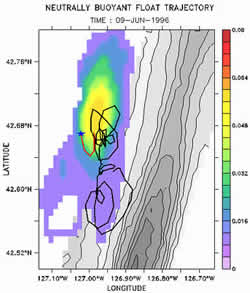| |
Monitoring
and Event Response Moorings
RAFOS floats
deployed in the neutrally buoyant plumes (largest total heat input), as
well as in Event plumes (largest short term heat input), increase our
understanding how these plumes become incorporated into the regional circulation.
 |
|
In 1996
an eruption detected by SOSUS occurred on the Northern Gorda Ridge.
An early response cruise found a large event plume in March, and a
second cruise found a different event plume in April. This event plume
became the first to be seeded and tracked with a neutrally buoyant
RAFOS drifter. The RAFOS drifter tracked the eddy-like rotation of
event plumes and allowed us, for the first time, to resample the same
plume 2 months later. Little chemical change was found between sampling
periods, suggesting that event plumes have a long residence time as
discrete entities in the deep ocean. The Gorda Ridge event was unusual
in another way, in that venting was extinguished within 3 months of
the eruption, much faster than at either Cleft or CoAxial. (Click
image for larger view.) |
View animation
of RAFOS float trajectory and plume model:
Quicktime player .mov (.2
Mb) | FLC player .fli (.2
Mb)
Player
downloads:
fli:
http://woodshole.er.usgs.gov/operations/modeling/flc.html
mov/mpeg: http://www.apple.com/quicktime/download/
Physical
Oceanography Methods: Current Meters
| CTD | RAFOS
|
|
